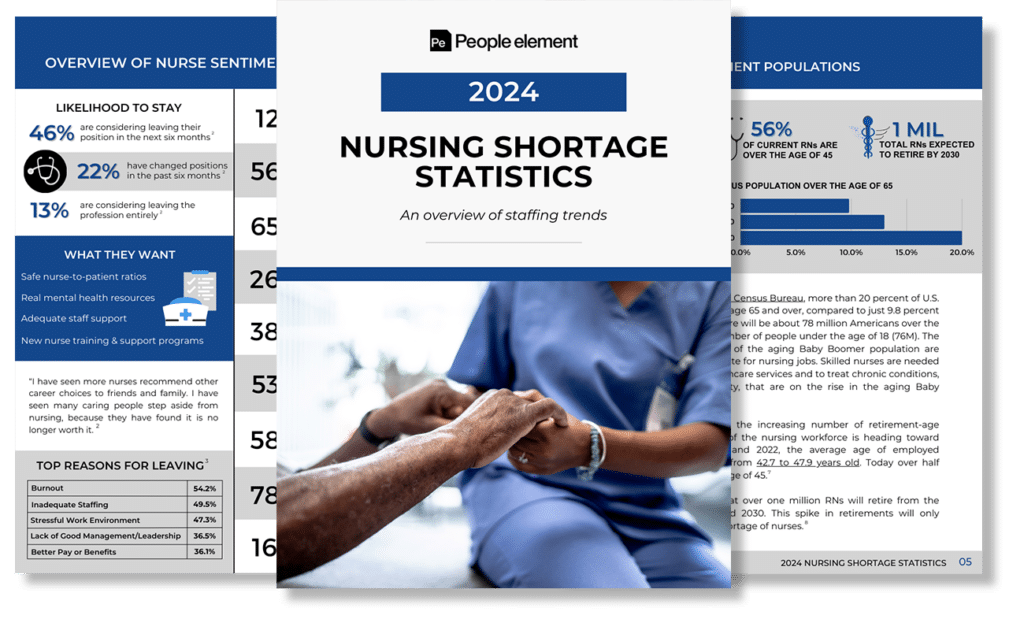
Free e-Book – 2024 Nursing Shortage Statistics
The healthcare industry is at a critical juncture, facing a looming nursing shortage that threatens to impede patient care and strain an already taxed healthcare system. This report leverages research-based statistics to explore predicted employment trends, providing the knowledge to effectively navigate this ongoing threat.
Overview of Nurse Sentiment
On the front lines of patient care, nurses are experiencing significant strain. The “2024 Nursing Shortage Statistics” E-book reports that over 60% of nurses acknowledge feeling burnt out and 22% have changed positions in the past six months. Moreover, 13% are considering leaving the profession entirely. This sentiment is due to factors like increased workloads, staffing shortages, and limited opportunities for training or advancement. Understanding this widespread burnout is crucial for HR professionals to develop strategies that improve nurse satisfaction and retention.
Growing Demand for Nurses
The demand for qualified nurses is projected to rise significantly in the coming years. Driven by an aging population and increasing healthcare needs, the U.S. Bureau of Labor Statistics predicts that about 177,400 additional Registered Nurses will be needed from 2022 to 2032, bringing the total RN employment from 3,172,500 in 2022 to a projected 3,349,900. With the nursing workforce struggling to keep pace, the gap between supply and demand is expected to widen.

Aging Nurse and Patient Populations
The nursing shortage is being compounded by a dual demographic trend: an aging nurse population and an aging patient population. Not only is a significant portion of the current nursing workforce nearing retirement age, but also it coincides with the Baby Boomer generation placing a greater demand on healthcare services. This creates a double-edged sword for the healthcare industry, as it grapples with both a shrinking workforce and a growing need for qualified nurses.
The Nursing Shortage Over Time
While the current nursing shortage is undeniably critical, it’s not a new phenomenon. This shortage has existed in various forms for some time and was exacerbated by the COVID-19 pandemic. As of 2024, 47.8% of hospitals reported a vacancy rate higher than 10%, a huge improvement from 81.3% in 2022. Understanding this historical context can help HR professionals plan for the long-term and develop sustainable solutions to address the ongoing shortage.
Most Severe Shortages Expected by 2036
Unfortunately, the picture doesn’t get much brighter moving forward. The report warns that the most severe shortages are expected to hit in the coming years. With nurse retirements projected to continue climbing and the influx of new nurses failing to meet the demand, the gap between available nurses and required positions is expected to widen considerably by 2036. This underscores the urgency for HR professionals to take proactive steps to secure a sustainable future workforce.

Cost of Nursing Turnover
The impact of the nursing shortage isn’t limited to patient care. This report highlights the significant financial burden shouldered by healthcare facilities due to nurse turnover. Factoring in recruitment, onboarding, and lost productivity, replacing a registered nurse can cost upwards of $50,000. This emphasizes the importance of investing in HR strategies that prioritize nurse retention and satisfaction, including collecting feedback from current staff.
Turnover by Tenure
Nurses within their first few years of practice are particularly likely to leave their positions, highlighting the importance of strong onboarding programs, mentorship opportunities, and support systems specifically designed for new nurses. By addressing the challenges faced by early-career nurses, HR professionals can improve retention rates and bolster their long-term workforce.
Nursing School Enrollment
While there’s a growing demand for nurses, filling the gap isn’t solely dependent on retaining current nurses. Enrollment trends at nursing schools show entry-level baccalaureate nursing programs decreased in 2022 for the first time in over 20 years, driven in part by these institutions lacking nursing faculty and resources. However, of the 217,000 students who graduated from a nursing program in 2023, gender and racial diversity has never been higher.





